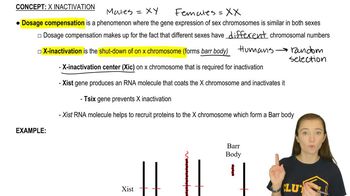Table of contents
- 1. Introduction to Genetics51m
- 2. Mendel's Laws of Inheritance3h 37m
- 3. Extensions to Mendelian Inheritance2h 41m
- 4. Genetic Mapping and Linkage2h 28m
- 5. Genetics of Bacteria and Viruses1h 21m
- 6. Chromosomal Variation1h 48m
- 7. DNA and Chromosome Structure56m
- 8. DNA Replication1h 10m
- 9. Mitosis and Meiosis1h 34m
- 10. Transcription1h 0m
- 11. Translation58m
- 12. Gene Regulation in Prokaryotes1h 19m
- 13. Gene Regulation in Eukaryotes44m
- 14. Genetic Control of Development44m
- 15. Genomes and Genomics1h 50m
- 16. Transposable Elements47m
- 17. Mutation, Repair, and Recombination1h 6m
- 18. Molecular Genetic Tools19m
- 19. Cancer Genetics29m
- 20. Quantitative Genetics1h 26m
- 21. Population Genetics50m
- 22. Evolutionary Genetics29m
2. Mendel's Laws of Inheritance
Sex-Linked Genes
Problem 25b
Textbook Question
Lesch–Nyhan syndrome (OMIM 300322) is a rare X-linked recessive disorder that produces severe mental retardation, spastic cerebral palsy, and self-mutilation.
If the first son of the woman described in (a) is affected, what is the probability that her second son is affected?
 Verified step by step guidance
Verified step by step guidance1
<span>Step 1: Understand the inheritance pattern. Lesch–Nyhan syndrome is an X-linked recessive disorder, which means the gene causing the disorder is located on the X chromosome.</span>
<span>Step 2: Determine the mother's genotype. Since the disorder is X-linked recessive and the first son is affected, the mother must be a carrier (heterozygous) for the disorder. This means she has one normal allele (X<sup>N</sup>) and one affected allele (X<sup>n</sup>).</span>
<span>Step 3: Consider the father's genotype. Since the disorder is X-linked, and males have only one X chromosome, the father's genotype does not affect the probability of the sons being affected. He contributes a Y chromosome to his sons.</span>
<span>Step 4: Calculate the probability for the second son. The mother can pass either her X<sup>N</sup> or X<sup>n</sup> chromosome to her son. Since the father contributes a Y chromosome, the probability that the second son inherits the X<sup>n</sup> chromosome from the mother (and thus is affected) is 50%.</span>
<span>Step 5: Conclude the probability. Since each son is an independent event, the probability that the second son is affected remains 50%, regardless of the first son's condition.</span>
Recommended similar problem, with video answer:
 Verified Solution
Verified SolutionThis video solution was recommended by our tutors as helpful for the problem above
Video duration:
2mPlay a video:
Was this helpful?
Key Concepts
Here are the essential concepts you must grasp in order to answer the question correctly.
X-linked Recessive Inheritance
X-linked recessive inheritance refers to genetic conditions that are associated with genes located on the X chromosome. Males, having one X and one Y chromosome, are more likely to express these disorders if they inherit a mutated X chromosome. Females, with two X chromosomes, can be carriers if they have one mutated X, but typically do not express the disorder unless both X chromosomes are affected.
Recommended video:
Guided course

X-Inactivation
Probability in Genetics
Probability in genetics involves calculating the likelihood of inheriting specific traits based on parental genotypes. In the case of X-linked disorders, the probability of a son being affected can be determined by considering the mother's genotype and whether she is a carrier or affected. This involves using Punnett squares or basic probability rules to assess the chances of inheritance.
Recommended video:
Guided course

Probability
Carrier Status
Carrier status refers to individuals who possess one copy of a mutated gene but do not exhibit symptoms of the associated disorder. In X-linked recessive conditions, a mother who is a carrier has one normal X chromosome and one mutated X chromosome. This status is crucial for determining the risk of passing the disorder to her offspring, particularly sons, who will inherit their X chromosome from her.
Recommended video:
Guided course

Sex-Linked Pedigrees

 7:56m
7:56mWatch next
Master Sex-Linked Genes with a bite sized video explanation from Kylia Goodner
Start learningRelated Videos
Related Practice



